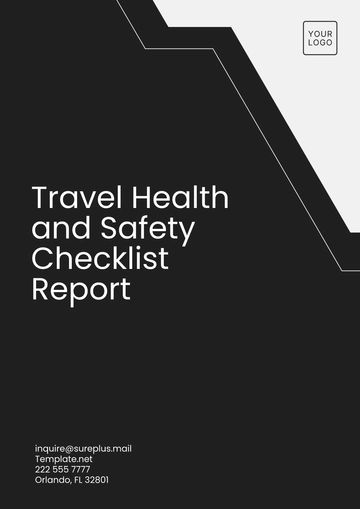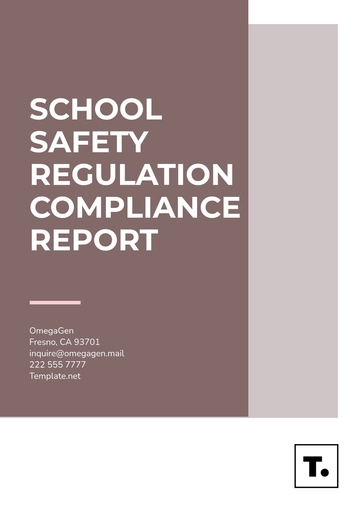Environmental Health and Safety (EHS) Report
Prepared by: [Your Name]
Company: [Your Company Name]
Date: December 6, 2053
1. Introduction
The primary objective of this Environmental Health and Safety (EHS) report is to provide a comprehensive analysis of our company's current EHS practices, with an emphasis on the health and safety of employees and the protection of the environment. This report examines the existing measures implemented to ensure workplace safety and environmental conservation, identifies areas for improvement, and offers actionable recommendations for further enhancement. Maintaining a robust EHS program is integral to our corporate responsibility and long-term sustainability goals.
Our company is dedicated to safeguarding the well-being of employees and minimizing the environmental impact of our operations. This report serves as a critical tool for fostering a culture of safety, responsibility, and environmental stewardship.
2. Current EHS Practices
2.1 Occupational Health and Safety
Our company has implemented a range of occupational health and safety measures aimed at mitigating risks and ensuring the well-being of employees. These measures include mandatory training, the provision of personal protective equipment (PPE), and ongoing safety audits.
Annual Safety Training: All employees are required to undergo safety training annually to stay informed about potential hazards and safety procedures.
Emergency Drills: Monthly emergency drills are conducted to prepare employees for various emergency scenarios, such as fires, chemical spills, and natural disasters.
PPE Provision: Personal protective equipment, including helmets, gloves, masks, and safety goggles, is provided to employees in high-risk areas to mitigate exposure to potential hazards.
Routine Safety Audits: The safety team conducts routine inspections to assess adherence to safety protocols and identify any areas that require improvement.
2.2 Environmental Management
Environmental management is at the core of our EHS strategy. Our approach focuses on minimizing waste, conserving energy, and preventing pollution, ensuring compliance with environmental regulations, and contributing to broader sustainability goals.
Waste Reduction Program: A comprehensive waste reduction program has been implemented to minimize waste generation and promote recycling initiatives.
Energy Efficiency Initiatives: The company has adopted energy-efficient technologies, such as LED lighting and energy management systems, to reduce energy consumption.
Environmental Compliance: We strictly adhere to all local, national, and international environmental regulations and standards, ensuring that our operations have minimal environmental impact.
Regular Environmental Monitoring: Environmental monitoring programs are in place to track air, water, and soil quality, as well as to assess the effectiveness of our waste reduction and energy conservation efforts.
2.3 Emergency Response and Preparedness
Effective emergency response and preparedness are essential in mitigating the impacts of unforeseen incidents. The company has developed detailed emergency response plans for various potential scenarios.
Emergency Type | Response Plan |
|---|
Fire | Evacuation procedures, fire drills, and firefighting equipment are readily available. |
Chemical Spill | Spill response kits, along with specialized training for employees in handling hazardous materials. |
Natural Disasters | Established disaster response protocols, including evacuation plans, communication strategies, and supplies for affected employees. |
2.4 Employee Health and Wellness Programs
Recognizing the importance of mental and physical health, we also focus on supporting employee wellness to reduce workplace stress, prevent burnout, and promote a healthy work-life balance.
On-Site Health Clinics: Our facilities are equipped with on-site clinics to provide immediate medical support.
Employee Assistance Programs (EAP): A dedicated support system for employees dealing with personal challenges that could affect their work or health.
Wellness Initiatives: Programs promoting physical activity, healthy eating, and stress management workshops are offered to employees.
3. Performance Analysis
3.1 Safety Performance
The company has made substantial progress in improving safety measures, resulting in a reduction in workplace incidents over the past few years.
Year | Number of Incidents | Incident Rate |
|---|
2050 | 50 | 5.0 |
2051 | 30 | 3.0 |
2052 | 15 | 1.5 |
Analysis: The steady reduction in the incident rate reflects the effectiveness of our safety measures and the growing commitment to fostering a culture of safety among employees. However, there remains room for further improvement in certain high-risk areas.
3.2 Environmental Performance
Our environmental performance has shown consistent progress, with notable advancements in waste management, energy efficiency, and compliance with environmental laws.
20% Reduction in Waste Generation: Through improved waste management practices and recycling programs, we have significantly decreased our waste footprint.
15% Improvement in Energy Efficiency: New technologies and energy-saving practices have led to a noticeable increase in energy efficiency.
Compliance with Environmental Regulations: We remain fully compliant with environmental regulations, ensuring no penalties or legal infractions in the past year.
4. Areas for Improvement
4.1 Occupational Safety Enhancements
Although our safety record has improved, several opportunities exist to further strengthen our safety culture:
Enhanced Employee Engagement: Foster greater participation in safety initiatives and encourage a proactive safety mindset among employees at all levels.
Advanced Incident Reporting: Implement more sophisticated incident reporting systems with predictive analytics to identify patterns and mitigate future risks.
Focus on High-Risk Areas: Target high-risk departments for more frequent and specialized safety training.
4.2 Environmental Initiatives
To elevate our environmental performance, we can focus on:
Exploring Renewable Energy: Investigate the potential for incorporating renewable energy sources (e.g., solar, wind) into our operations to reduce our carbon footprint.
Water Conservation: Expand efforts to conserve water in our manufacturing and facility operations.
Green Procurement Policy: Develop a policy prioritizing sustainable sourcing, which will encourage the purchase of eco-friendly products and materials.
5. Recommendations for Improvement
5.1 Safety Recommendations
To further improve our occupational safety, we recommend:
Virtual Reality (VR) Safety Training: Integrating VR simulations to provide realistic, immersive training experiences for employees, enhancing their preparedness for emergencies.
Wearable Safety Technology: Introduce wearable devices to monitor employee health and safety metrics in real time, providing alerts for potential hazards such as heat stress or fatigue.
Integrated EHS Management System: Implement an advanced EHS software platform to streamline data collection, reporting, and analysis, enabling data-driven decision-making.
5.2 Environmental Recommendations
To reduce our environmental impact and improve our sustainability efforts, we suggest:
Comprehensive Recycling Program: Expand recycling initiatives across all facilities, ensuring that employees have easy access to recycling stations and educational materials.
Community Collaboration: Partner with local communities and environmental organizations to undertake larger-scale conservation and sustainability projects.
Carbon Neutrality Targets: Establish clear, measurable targets for achieving carbon neutrality and develop a roadmap to meet these goals.
6. Conclusion
In conclusion, this report provides a comprehensive overview of our company's current EHS practices, safety performance, and environmental impact. While we have made significant strides in ensuring the safety and well-being of our employees and improving environmental management, there is always room for further improvement. By adopting the recommendations outlined in this report, we can enhance our safety culture, reduce our environmental footprint, and demonstrate our continued commitment to sustainability. Our company remains dedicated to fostering a safe, healthy, and environmentally responsible workplace for all employees.
Report Templates @ Template.net






























